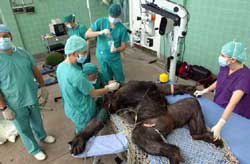Gorilla regains sight in ground-breaking operation by Bristol Zoo Gardens

Romina, a female Western lowland gorilla at Bristol Zoo Gardens, has successfully undergone pioneering surgery to restore her sight in the first ever cataract operation performed in Europe on an adult gorilla. Born with cataracts, 21-year-old Romina underwent the two-hour procedure at the University of Bristol`s Veterinary Hospital in March and, for the first time in her life, she can now see the world around her clearly.
Romina was born at Rome Zoo and hand-reared. Before her arrival in the UK in November 2001, Bristol Zoo Gardens were notified of concerns about her eyesight. Health checks carried out by Head of Veterinary Services at Bristol Zoo Gardens, Sharon Redrobe, revealed that she had cataracts in both eyes, allowing only minimal peripheral vision.
Jenny Watts, a medical ophthalmologist from the Royal Hampshire County Hospital, Winchester carried out the delicate surgery assisted by veterinary ophthalmologist David Gould, from the University of Bristol.
With only a handful of operations of this kind having been carried out on gorillas before, and this the first of its kind in Europe, the team lacked basic information such as the exact structure of a gorilla`s eye. Although this operation is usually carried out on conscious patients in human medicine, accurate anaesthesia was critical to ensure that the 120kg gorilla remained completely unconscious throughout the operation.
The majority of the operation was taken up by detailed ultrasound measurements of the eye to calculate the strength of the artificial lens required. A process called phaco-emulsification was used to break up the cloudy cataract by ultrasound, so that it could be removed prior to the insertion of the foldable silicon artificial lens – exactly the same procedure carried out in human cataract surgery.
Following the successful outcome of this first operation, a second cataract operation is planned to restore Romina`s bilateral vision. Sharon Redrobe, Bristol Zoo Garden`s vet, said: “As soon as Romina came round from the operation we could tell that she could see. She immediately reached towards food without resorting to feeling her way. We`re delighted that the operation has been so successful and that she is having the chance to explore her surroundings and companions properly for the first time.”
Romina has now been reunited with her companions, 18-year-old silverback male Bongo and 25-year-old female Salome, after a period of post-operative recuperation – during which the risk of infection was the greatest concern. Melanie Gage, Overseer of Primates, explained: “We had to encourage Romina to come as close as possible to the keeping team so that we could safely give her antibiotic eye drops four times a day both before and following the operation. In the end, we devised a system of drizzling the solution through a catheter, so that the drops ran gently into her eye.”
Romina and Bongo joined Salome at Bristol Zoo Gardens from Rome Zoo in November 2001 as part of the international conservation breeding programme for the western lowland gorilla. Dr Jo Gipps, Director of Bristol Zoo Gardens, explained: “It used to be thought that lowland gorillas were significantly more plentiful than their highly threatened cousins, mountain gorillas. Now, forest destruction for logging and the effect of the illegal bushmeat trade means that lowland gorillas face serious losses in the wild population. So Romina, Bongo and Salome are extremely important and we very much hope that they will go on to breed in the near future. With her convalescence over, visitors can see Romina and her companions on Bristol Zoo Gardens` Gorilla Island and find out more about these noble creatures.
“They can also learn about the Zoo`s conservation work to protect gorillas in the wild and the significant role we are playing in the European-wide Bushmeat Campaign to halt this illegal trade.”
Media Contact
All latest news from the category: Health and Medicine
This subject area encompasses research and studies in the field of human medicine.
Among the wide-ranging list of topics covered here are anesthesiology, anatomy, surgery, human genetics, hygiene and environmental medicine, internal medicine, neurology, pharmacology, physiology, urology and dental medicine.
Newest articles

NTU and NUS spin-off cutting-edge quantum control technology
AQSolotl’s quantum controller is designed to be adaptable, scalable and cost-efficient. Quantum technology jointly developed at Nanyang Technological University, Singapore (NTU Singapore) and National University of Singapore (NUS) has now…

How Geothermal Energy Shapes Bavaria’s Green Future Through Sustainable Energy
The Bavarian State Ministry of Science and the Arts has extended its funding for the research association “Geothermal Alliance Bavaria,” with the University of Bayreuth (UBT) continuing as a member…

Spintronics memory innovation: A new perpendicular magnetized film
Long gone are the days where all our data could fit on a two-megabyte floppy disk. In today’s information-based society, the increasing volume of information being handled demands that we…



